澳门英文PPT描述
- 格式:ppt
- 大小:6.70 MB
- 文档页数:19
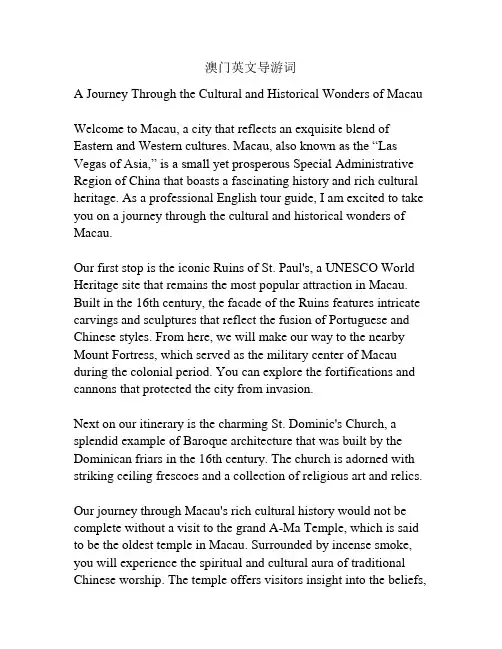
澳门英文导游词A Journey Through the Cultural and Historical Wonders of MacauWelcome to Macau, a city that reflects an exquisite blend of Eastern and Western cultures. Macau, also known as the “Las Vegas of Asia,” is a small yet prosperous Special Administrative Region of China that boasts a fascinating history and rich cultural heritage. As a professional English tour guide, I am excited to take you on a journey through the cultural and historical wonders of Macau.Our first stop is the iconic Ruins of St. Paul's, a UNESCO World Heritage site that remains the most popular attraction in Macau. Built in the 16th century, the facade of the Ruins features intricate carvings and sculptures that reflect the fusion of Portuguese and Chinese styles. From here, we will make our way to the nearby Mount Fortress, which served as the military center of Macau during the colonial period. You can explore the fortifications and cannons that protected the city from invasion.Next on our itinerary is the charming St. Dominic's Church, a splendid example of Baroque architecture that was built by the Dominican friars in the 16th century. The church is adorned with striking ceiling frescoes and a collection of religious art and relics. Our journey through Macau's rich cultural history would not be complete without a visit to the grand A-Ma Temple, which is said to be the oldest temple in Macau. Surrounded by incense smoke, you will experience the spiritual and cultural aura of traditional Chinese worship. The temple offers visitors insight into the beliefs,customs, and traditions of Chinese religion and culture.Moving on, we will head to the Macau Museum to gain a deeper understanding of the fascinating history and culture of Macau. The museum houses a vast collection of artifacts, vintage pictures, and informative exhibits that reveal the unique blend of cultures that characterizes this vibrant city. You will walk through the different time periods that shaped Macau's rich history.One of the quintessential aspects of Macau's vibrant and lively culture is its culinary diversity. We will take a foodie detour to savor the best of the local Macanese cuisine. You will indulge your taste buds with delicacies such as the famous Macau-style Portuguese egg tarts, African chicken, and pork chop buns. You will discover why Macau was labelled a "creole city," an intersection of Chinese, European, and many other gastronomic cultures.Finally, we will make our way to the modern and luxurious Cotai Strip, Macau's famous entertainment district. The Cotai Strip features a plethora of world-renowned hotels, casinos, shopping malls, and theaters, including The Venetian Macao, the biggest casino in the world. The district also hosts the House of Dancing Water, a breath-taking water show that combines acrobatic performances, culture, and art in one fantastic production.In conclusion, Macau offers a fascinating blend of history, culture, and entertainment, all embedded in the distinctive Chinese and Portuguese traditions. This journey through the cultural and historical wonders of Macau is a memory that you will hold dearforever. Thank you for choosing to explore this inclusive and multicultural city with me. Don't forget to come back for more!As we continue our journey through Macau, we will explore more of the city's rich cultural and historical heritage.One of the must-visit attractions in Macau is the Senado Square, located in the heart of the city's historic center. This charming square is surrounded by pastel-colored Portuguese buildings that reflect the city's colonial past. You'll enjoy a leisurely stroll around the square, admiring the striking architectural details and watching the city's local street performers.From Senado Square, we will walk to the nearby Leal Senado building, which is one of the most significant landmarks in Macau. Built in the 18th century, the building served as the city's administrative center and courthouse and is now home to the Macau Government Tourist Office. You can witness the stunning blend of Eastern and Western architecture at the Leal Senado building.Our next stop is the Macau Tower, the city's most iconic landmark. You can admire the breathtaking panoramic views of the city from the tower's observation deck, located at a height of 223 meters above ground. For the more adventurous, you can experience the thrill of the Tower's Skyjump or the bungee jump, the highest in the world, from its highest point.For those interested in Macau's artistic scene, we will visit the Macau Art Museum. The museum hosts a curated collection of contemporary and traditional art that showcases the city's culturalblend of cultures. You can admire works by local and international artists and attend exhibitions, workshops, and cultural activities.Moving on, we will visit the Guia Fortress and Lighthouse, located on top of a hill overlooking the city. The illuminating lighthouse was built in the early 17th century and has since guided sailors safely into Macau's harbor. You can explore the fortifications and enjoy the stunning views of the city.Next, we will head to the Coloane Village, located on the southern part of the Macau Peninsula. The charming village offers visitors a glimpse of traditional Macanese life, complete with colonial-style villas, quiet alleys, and seafood joints. You can indulge in local delicacies such as the famous Macau-style Portuguese egg tarts, almond cookies, and shrimp roe noodles.As our journey through Macau draws to a close, we will end our tour at the Fisherman's Wharf, Macau's first-ever themed entertainment attraction. The Wharf boasts a diverse range of retail, dining, entertainment, and leisure offerings inspired by different themes such as ancient Rome, Pirate's Den, and the Legend of Greek.In conclusion, Macau is a city that appeals to visitors from all walks of life, with its fascinating blend of cultures, history, and entertainment. From its historic landmarks to its modern-day attractions, Macau is a city with something for everyone. As your tour guide, I hope you've enjoyed this journey through the cultural and historical wonders of Macau and that you will return soon to explore its many attractions further.。
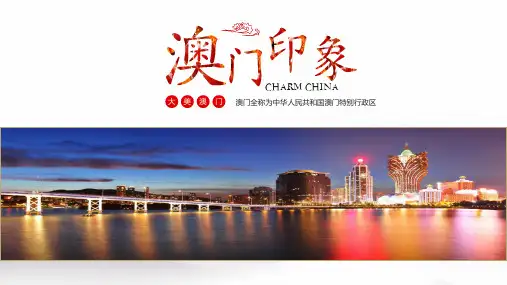
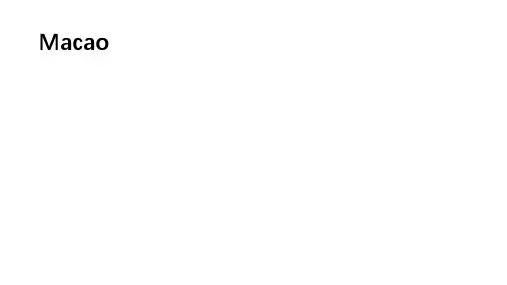
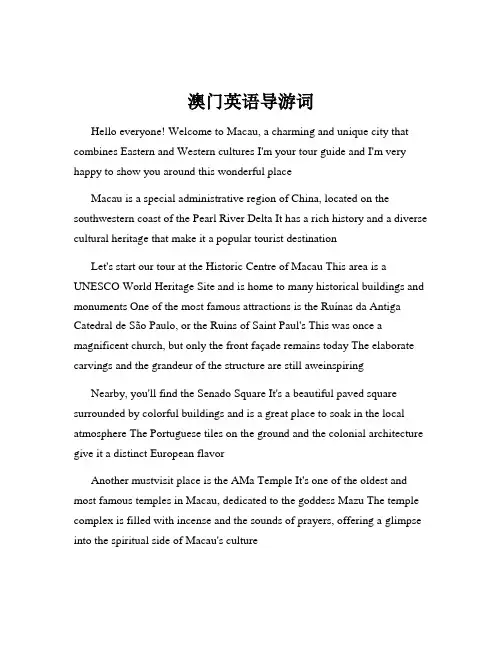
澳门英语导游词Hello everyone! Welcome to Macau, a charming and unique city that combines Eastern and Western cultures I'm your tour guide and I'm very happy to show you around this wonderful placeMacau is a special administrative region of China, located on the southwestern coast of the Pearl River Delta It has a rich history and a diverse cultural heritage that make it a popular tourist destinationLet's start our tour at the Historic Centre of Macau This area is a UNESCO World Heritage Site and is home to many historical buildings and monuments One of the most famous attractions is the Ruínas da Antiga Catedral de São Paulo, or the Ruins of Saint Paul's This was once a magnificent church, but only the front façade remains today The elaborate carvings and the grandeur of the structure are still aweinspiringNearby, you'll find the Senado Square It's a beautiful paved square surrounded by colorful buildings and is a great place to soak in the local atmosphere The Portuguese tiles on the ground and the colonial architecture give it a distinct European flavorAnother mustvisit place is the AMa Temple It's one of the oldest and most famous temples in Macau, dedicated to the goddess Mazu The temple complex is filled with incense and the sounds of prayers, offering a glimpse into the spiritual side of Macau's cultureMacau is also known for its casinos The Venetian Macao Resort is a huge complex that not only offers gambling but also has a shopping mall, restaurants, and entertainment shows The interior is designed to look like Venice, complete with canals and gondolasWhen it comes to food, Macau has a wide range of delicious options Macanese cuisine is a fusion of Portuguese and Chinese flavors Don't miss the opportunity to try Macau's famous egg tarts, Portuguese grilled chicken, and various dim sumThe local markets are also worth exploring The Red Market is a great place to buy fresh produce and local specialties You can also find handicrafts and souvenirs to take homeAfter a busy day of sightseeing, you can relax at one of Macau's beautiful beaches Hac Sa Beach is a popular choice, with its black sand and clear watersIn the evening, the city comes alive with lights The Macau Tower is a spectacular sight, especially when it's illuminated You can even take a thrilling bungee jump from the top if you're feeling adventurousTo get around Macau, you can use the public buses or taxis There are also trams in some areas that offer a unique way to exploreI hope you've enjoyed our tour of Macau There's so much more to discover in this vibrant city, and I'm sure you'll leave with wonderful memories Thank you for joining me today!That's all for our tour I wish you all a pleasant stay in Macau Goodbye!。
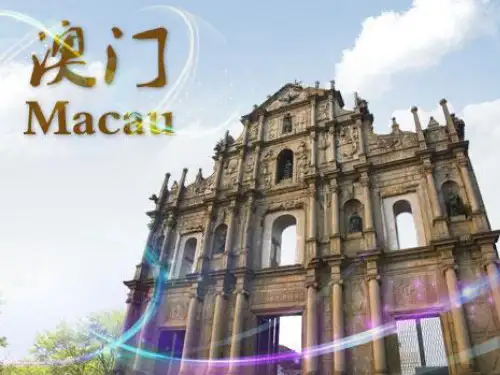
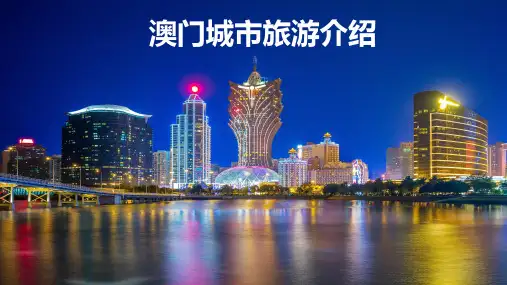
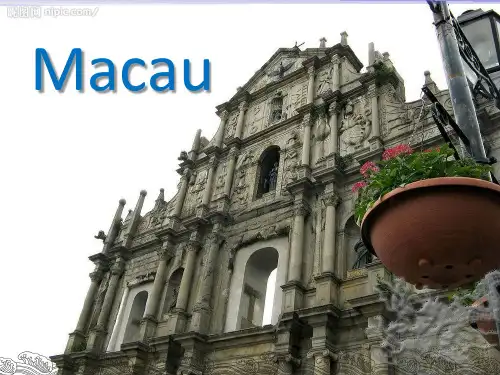
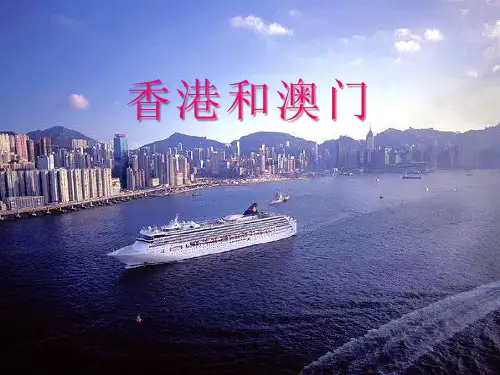
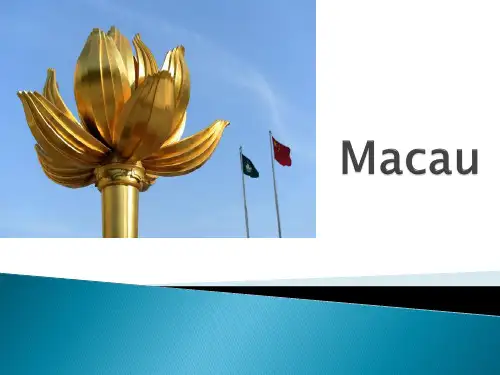
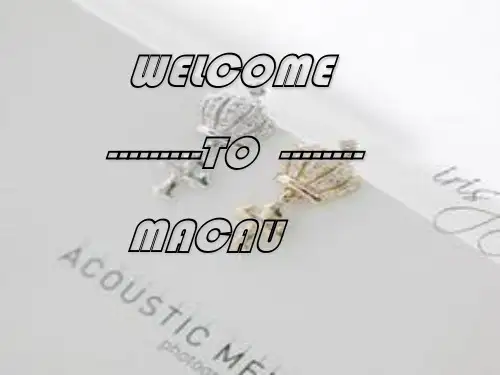
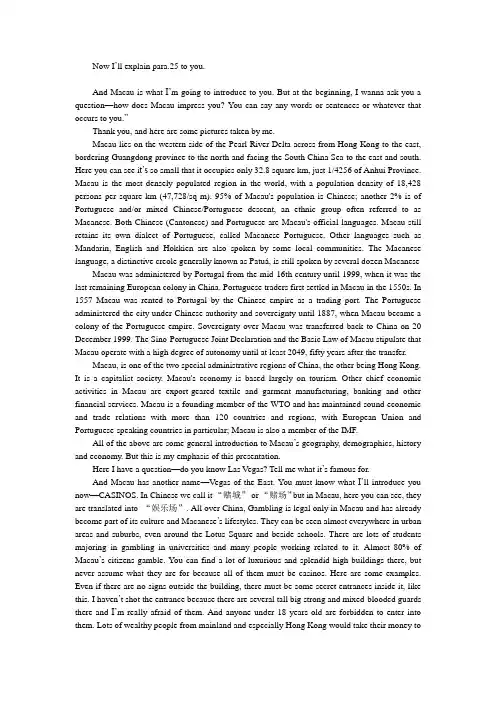
Now I’ll explain para.25 to you.And Macau is what I’m going to introduce to you. But at the beginning, I wanna ask you a question—how does Macau impress you? Y ou can say any words or sentences or whatever that occurs to you.”Thank you, and here are some pictures taken by me.Macau lies on the western side of the Pearl River Delta across from Hong Kong to the east, bordering Guangdong province to the north and facing the South China Sea to the east and south. Here you can see i t’s so small that it occupies only 32.8 square km, just 1/4256 of Anhui Province. Macau is the most densely populated region in the world, with a population density of 18,428 persons per square km (47,728/sq m). 95% of Macau's population is Chinese; another 2% is of Portuguese and/or mixed Chinese/Portuguese descent, an ethnic group often referred to as Macanese. Both Chinese (Cantonese) and Portuguese are Macau's official languages. Macau still retains its own dialect of Portuguese, called Macanese Portuguese. Other languages such as Mandarin, English and Hokkien are also spoken by some local communities. The Macanese language, a distinctive creole generally known as Patuá, is still spoken by several dozen Macanese Macau was administered by Portugal from the mid-16th century until 1999, when it was the last remaining European colony in China. Portuguese traders first settled in Macau in the 1550s. In 1557 Macau was rented to Portugal by the Chinese empire as a trading port. The Portuguese administered the city under Chinese authority and sovereignty until 1887, when Macau became a colony of the Portuguese empire. Sovereignty over Macau was transferred back to China on 20 December 1999. The Sino-Portuguese Joint Declaration and the Basic Law of Macau stipulate that Macau operate with a high degree of autonomy until at least 2049, fifty years after the transfer.Macau, is one of the two special administrative regions of China, the other being Hong Kong. It is a capitalist society. Macau's economy is based largely on tourism. Other chief economic activities in Macau are export-geared textile and garment manufacturing, banking and other financial services. Macau is a founding member of the WTO and has maintained sound economic and trade relations with more than 120 countries and regions, with European Union and Portuguese-speaking countries in particular; Macau is also a member of the IMF.All of the above are some general introduction to Macau’s geography, demographics, history and economy. But this is my emphasis of this presentation.Here I have a question—do you know Las V egas? Tell me what it’s famous for.And Macau has another name—V egas of the East. Y ou must know what I’ll introduce you now—CASINOS. In Chinese we call it “赌城”or “赌场”but in Macau, here you can see, they are translated into “娱乐场”. All over China, Gambling is legal only in Macau and has already become part of its culture and Macanese’s lifestyles. They can be seen almost everywhere in urban areas and suburbs, even around the Lotus Square and beside schools. There are lots of students majoring in gambling in universities and many people working related to it. Almost 80% of Macau’s citizens gamble. Y ou can find a lot of luxurious and splendid high buildings there, but never assume what they are for because all of them must be casinos. Here are some examples. Even if there are no signs outside the building, there must be some secret entrances inside it, like this. I haven’t shot the entrance because there are several tall big strong and mixed-blooded guards there and I’m really afraid of them. And anyone under 18 years old are forbidden to enter into them. Lots of wealthy people from mainland and especially Hong Kong would take their money tocasinos in Macau to earn more and to enjoy themselves because there are pubs with pretty girls in casinos, of course, sometimes they may lose everything, but they may just come back to earn enough money and to gamble or to overindulge in the joy again.And I have only had the chance to visit two of them, the V enetian, the biggest one, and Lisboa Casino, the oldest one. Of course I’m not courageous and rich enough to gamble and there are too many people there. I just do some visiting and watch others playing. Here are some pictures I shot in V enetian shopping mall. The sky is very beautiful and alluring but they are artificial, there are still more than 40 floors above it and the sky can change according to different weather and changing time of a day. And the shopping mall copies the structure of V enice in Italy, the same acreage, same architectural style, same three canals and the boatmen and some actors and actresses are singing Italian operas. Almost all kinds of shops can be found there—clothing stores, pharmacies, souvenir shops, food outlets, jewelry shops starbuck, Haagen-Dazs and so on. But things there are surely very expensive. It took us nearly three hours to hang around in just one floor.And the other one is Lisboa Casino. There are two of them, the old one and the new one. I just spent 30 minutes watching others gambling in the old one and found that gambling is very simple to learn but also easy to get indulged in it. If you win, you want to win more; and if you lose, you want to have your money back, which makes gambling so hard to quit. We can only stay in the first floor, where gamblers can play at any stake, 50 100 and 200 are all OK. But the upper the floor is, the more stakes you have to pay and the bigger risks you are taking. VIPs certainly enjoy service of highest quality—they can live in the best rooms, eat in the best restaurants and take limousines. I’ve heard that once there was an old lady winning 30 million over one night and next day the owner of Lisboa Casino, He Hung San, sent her back home with his private helicopter.The new Lisboa Casino is next to the old one, I’ve heard that one of the bronze statues of Chinese zodiac from Y uanming Y uan, the horse head, had been bought by He Hung San and placed in the new one, through which we can see how rich He Hung San is. As an icon of Macau and even Hong Kong, he should really be introduced but it’s a pity that time is so limited, maybe you can find something about him by yourself.That is all my presentation, thank you for you attention.。
澳门历史城区英语介绍-回复The Historical Center of Macau: A Journey Through Time and CultureIntroductionIn the heart of East Asia lies Macau, a small peninsula and two islands that were formerly colonies of the Portuguese Empire. Macau has a rich history deeply intertwined with both Eastern and Western influences. One of the most remarkable attractions in this fascinating city is its historical center, a UNESCO World Heritage site, displaying the unique fusion of Chinese and Portuguese architectural styles. This article aims to provide a comprehensive overview of the historical center of Macau, exploring its history, cultural significance, and attractions.I. Early History of Macau1.1 The Arrival of the PortugueseThe history of Macau as a European settlement began in the early 16th century when Portuguese sailors, led by Jorge Álvares, arrived on the shores of Macau seeking a safe harbor. The Portugueseestablished trade routes, fostering cultural exchange with the Chinese and other Asian civilizations.1.2 The Formation of a Trading PostIn 1557, the Ming Dynasty granted the Portuguese permission to settle in Macau, creating a trading post and leasing the territory to the Portuguese Empire. This marked the beginning of Portuguese colonization in East Asia.II. Cultural Hybridization2.1 European and Chinese BlendsThe historical center of Macau represents the perfect harmony between Chinese and European cultures. The architectural structures, narrow intricate streets, and vibrant squares showcase the fusion of Chinese and Portuguese elements. The buildings incorporate Chinese decorative motifs, such as dragons, alongside the iconic Portuguese tiles and pastel colors.2.2 Religious InstitutionsMacau's historical center boasts numerous religious institutions that showcase the region's cultural diversity. The Ruins of St. Paul's,a UNESCO World Heritage site and Macau's most famous landmark, exhibits the combination of Chinese and European influences in its facade. The A-Ma Temple, dedicated to the goddess of seafarers, pays tribute to Macau's Chinese heritage.III. Historical Landmarks3.1 The Ruins of St. Paul'sAs mentioned earlier, the Ruins of St. Paul's is an emblematic symbol of Macau. Originally built in the 16th century, it was once the largest Catholic church in Asia. Today, visitors can witness the intricate stone carvings and the Jesuit College's remaining facade.3.2 Mount FortressAdjacent to the Ruins of St. Paul's, Mount Fortress served as a defensive structure for Macau during the colonial era. This historical landmark offers breathtaking panoramic views of the city and houses the Macau Museum, where visitors can delve into the city's history and heritage.3.3 Senado SquareSenado Square, the heart of Macau's historical center, representsthe city's vibrant public life. Surrounded by colonial-era buildings, including the Leal Senado building, it is a UNESCO World Heritage site displaying attractive Portuguese pavement patterns and vibrant cultural events.IV. The Cultural Significance4.1 UNESCO World Heritage SiteIn 2005, Macau's Historical Center was listed as a UNESCO World Heritage site, acknowledging its outstanding universal value and importance to humanity. The historical center symbolizes the multicultural heritage and unique blend of Eastern and Western influences.4.2 The Birthplace of East-West Cultural ExchangeMacau's historical center played a crucial role in facilitating cultural exchange between the East and the West. The city served as a gateway for the introduction of Western scientific knowledge and philosophy to China, while also exporting Chinese cultural elements to European countries through trade routes.Conclusion:The historical center of Macau stands as a testament to the city's vibrant past and its cultural diversity. As visitors stroll through its narrow streets and marvel at the architectural wonders, they are transported back in time, witnessing the profound historical and cultural connections between East and West. Macau's historical center is not simply a collection of buildings; it is a living legacy that embodies the beauty of cultural hybridization and the power of human interaction across borders.。
澳门介绍英文作文Macao, also known as Macau, is a special administrative region of China. It is located on the southern coast of China and is known for its vibrant nightlife, rich history, and unique blend of Chinese and Portuguese cultures.The most famous landmark in Macao is the Ruins of St. Paul's, which is the facade of a 17th-century church that was destroyed by fire in the 19th century. It is a symbol of Macao's rich colonial history and is a popular tourist attraction.In addition to its historical attractions, Macao is also famous for its casinos and luxury hotels. The city's Cotai Strip is home to some of the world's largest and most extravagant casinos, making it a popular destination for gamblers and tourists alike.Macao is also known for its delicious cuisine, which is a fusion of Chinese and Portuguese flavors. Some must-trydishes include Portuguese egg tarts, pork chop buns, and Macanese-style seafood. The city is also home to a numberof Michelin-starred restaurants, making it a paradise for food lovers.In recent years, Macao has also become a hub for entertainment and cultural events. The city hosts an annual International Fireworks Display Contest, as well as a number of music festivals and international sporting events.Overall, Macao is a vibrant and dynamic city thatoffers a unique blend of history, culture, and entertainment. Whether you're interested in exploring its historical landmarks, trying your luck at the casinos, or indulging in its delicious cuisine, there's something for everyone in this exciting city.。